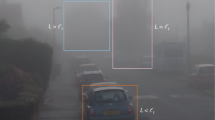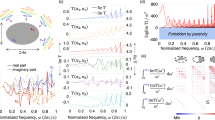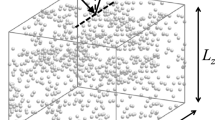Abstract
Complex and inhomogeneous media are ubiquitous around us. Snow, fog, biological tissues and turbid water — even just a piece of frosted glass — are opaque to light due to scattering. Similarly, radio waves bounce and mix around buildings in cities, and acoustic waves reverberate in our bodies or across the Earth’s mantle. Although this scattering process seems to mix and completely destroy all information, thus preventing imaging or communication, a different approach has emerged — exploiting this apparently detrimental effect to one’s advantage by processing information carried by waves. This Perspective discusses how this powerful concept has recently triggered a wealth of advances in imaging and computing.
This is a preview of subscription content, access via your institution
Access options
Access Nature and 54 other Nature Portfolio journals
Get Nature+, our best-value online-access subscription
$29.99 / 30 days
cancel any time
Subscribe to this journal
Receive 12 print issues and online access
$209.00 per year
only $17.42 per issue
Buy this article
- Purchase on Springer Link
- Instant access to full article PDF
Prices may be subject to local taxes which are calculated during checkout



Similar content being viewed by others
References
Goodman, J. W. Some fundamental properties of speckle. J. Opt. Soc. Am. 66, 1145–1150 (1976).
Aubry, A. & Derode, A. Random matrix theory applied to acoustic backscattering and imaging in complex media. Phys. Rev. Lett. 102, 084301 (2009).
Popoff, S. M. et al. Measuring the transmission matrix in optics: an approach to the study and control of light propagation in disordered media. Phys. Rev. Lett. 104, 100601 (2010).
Rotter, S. & Gigan, S. Light fields in complex media: mesoscopic scattering meets wave control. Rev. Mod. Phys. 89, 015005 (2017).
Mosk, A. P., Lagendijk, A., Lerosey, G. & Fink, M. Controlling waves in space and time for imaging and focusing in complex media. Nat. Photon. 6, 283–292 (2012).
Bertolotti, J. & Katz, O. Imaging in complex media. Nat. Phys. https://doi.org/10.1038/s41567-022-01723-8 (2022).
Beenakker, C. W. Random-matrix theory of quantum transport. Rev. Mod. Phys. 69, 731 (1997).
Cao, H., Mosk, A. P. & Rotter, S. Shaping the propagation of light in complex media. Nat. Phys. https://doi.org/10.1038/s41567-022-01677-x (2022).
Goetschy, A. & Stone, A. Filtering random matrices: the effect of incomplete channel control in multiple scattering. Phys. Rev. Lett. 111, 063901 (2013).
Pappu, R., Recht, B., Taylor, J. & Gershenfeld, N. Physical one-way functions. Science 297, 2026–2030 (2002).
Goorden, S. A., Horstmann, M., Mosk, A. P., Škorić, B. & Pinkse, P. W. Quantum-secure authentication of a physical unclonable key. Optica 1, 421–424 (2014).
Xiong, W. et al. Spatiotemporal control of light transmission through a multimode fiber with strong mode coupling. Phys. Rev. Lett. 117, 053901 (2016).
Baranger, H. U. & Mello, P. A. Mesoscopic transport through chaotic cavities: a random S-matrix theory approach. Phys. Rev. Lett. 73, 142 (1994).
Wigner, E. P. Random matrices in physics. SIAM Rev. 9, 1–23 (1967).
Mehta, M. L. Random Matrices (Elsevier, 2004).
Wishart, J. The generalised product moment distribution in samples from a normal multivariate population. Biometrika 20, 32–52 (1928).
Marčenko, V. A. & Pastur, L. A. Distribution of eigenvalues for some sets of random matrices. Math. USSR Sb. 1, 507–536 (1967).
Wigner, E. P. Characteristic vectors of bordered matrices with infinite dimensions. Ann. Math. 62, 548–564 (1955).
Achlioptas, D. Database-friendly random projections: Johnson-lindenstrauss with binary coins. J. Comput. Syst. Sci. 66, 671–687 (2003).
Mahoney, M. W. Randomized algorithms for matrices and data. Found. Trends Mach. Learn. 3, 123–224 (2011).
Rahimi, A., Recht, B. et al. Random features for large-scale kernel machines. In Advances in Neural Information Processing Systems 20 (NIPS, 2007).
Candes, E. J. & Tao, T. Near-optimal signal recovery from random projections: universal encoding strategies? IEEE Trans. Inf. theory 52, 5406–5425 (2006).
Baraniuk, R., Davenport, M., DeVore, R. & Wakin, M. A simple proof of the restricted isometry property for random matrices. Constr. Approx. 28, 253–263 (2008).
Fergus, R., Torralba, A. & Freeman, W. T. Random Lens Imaging (MIT CSAIL, 2006); http://people.csail.mit.edu/billf/publications/Random_Lens_Imaging.pdf
Asif, M. S., Ayremlou, A., Sankaranarayanan, A., Veeraraghavan, A. & Baraniuk, R. G. Flatcam: thin, lensless cameras using coded aperture and computation. IEEE Trans. Comput. Imag. 3, 384–397 (2016).
Marković, D., Mizrahi, A., Querlioz, D. & Grollier, J. Physics for neuromorphic computing. Nat. Rev. Phys. 2, 499–510 (2020).
Liutkus, A. et al. Imaging with nature: compressive imaging using a multiply scattering medium. Sci. Rep. 4, 5552 (2014).
Sefler, G. A., Shaw, T. J. & Valley, G. C. Demonstration of speckle-based compressive sensing system for recovering rf signals. Opt. Express 26, 21390–21402 (2018).
Sleasman, T., Imani, M. F., Gollub, J. N. & Smith, D. R. Microwave imaging using a disordered cavity with a dynamically tunable impedance surface. Phys. Rev. Appl. 6, 054019 (2016).
Antipa, N. et al. Diffusercam: lensless single-exposure 3d imaging. Optica 5, 1–9 (2018).
Berto, P., Rigneault, H. & Guillon, M. Wavefront sensing with a thin diffuser. Opt. Lett. 42, 5117–5120 (2017).
Moretti, C. & Gigan, S. Readout of fluorescence functional signals through highly scattering tissue. Nat. Photon. 14, 361–364 (2020).
Redding, B. & Cao, H. Using a multimode fiber as a high-resolution, low-loss spectrometer. Opt. Lett. 37, 3384–3386 (2012).
Redding, B., Liew, S. F., Sarma, R. & Cao, H. Compact spectrometer based on a disordered photonic chip. Nat. Photon. 7, 746–751 (2013).
Horisaki, R., Takagi, R. & Tanida, J. Learning-based imaging through scattering media. Opt. Express 24, 13738–13743 (2016).
Satat, G., Tancik, M., Gupta, O., Heshmat, B. & Raskar, R. Object classification through scattering media with deep learning on time resolved measurement. Opt. Express 25, 17466–17479 (2017).
Li, Y., Xue, Y. & Tian, L. Deep speckle correlation: a deep learning approach toward scalable imaging through scattering media. Optica 5, 1181–1190 (2018).
Li, S., Deng, M., Lee, J., Sinha, A. & Barbastathis, G. Imaging through glass diffusers using densely connected convolutional networks. Optica 5, 803–813 (2018).
Borhani, N., Kakkava, E., Moser, C. & Psaltis, D. Learning to see through multimode fibers. Optica 5, 960–966 (2018).
Rahmani, B., Loterie, D., Konstantinou, G., Psaltis, D. & Moser, C. Multimode optical fiber transmission with a deep learning network. Light. Sci. Appl. 7, 69 (2018).
del Hougne, M., Gigan, S. & del Hougne, P. Deeply sub-wavelength localization with reverberation-coded-aperture. Phys. Rev. Lett. 127, 043903 (2021).
Turpin, A., Vishniakou, I. & d Seelig, J. Light scattering control in transmission and reflection with neural networks. Opt. Express 26, 30911–30929 (2018).
Caramazza, P., Moran, O., Murray-Smith, R. & Faccio, D. Transmission of natural scene images through a multimode fibre. Nat. Commun. 10, 2029 (2019).
Kellman, M. R., Bostan, E., Repina, N. A. & Waller, L. Physics-based learned design: optimized coded-illumination for quantitative phase imaging. IEEE Trans. Comput. Imag. 5, 344–353 (2019).
Kamilov, U. S. et al. Learning approach to optical tomography. Optica 2, 517–522 (2015).
Horstmeyer, R., Chen, R. Y., Kappes, B. & Judkewitz, B. Convolutional neural networks that teach microscopes how to image. Preprint at https://arxiv.org/abs/1709.07223 (2017).
Elmalem, S., Giryes, R. & Marom, E. Learned phase coded aperture for the benefit of depth of field extension. Opt. Express 26, 15316–15331 (2018).
Karniadakis, G. E. et al. Physics-informed machine learning. Nat. Rev. Phys. 3, 422–440 (2021).
Ando, T., Horisaki, R. & Tanida, J. Speckle-learning-based object recognition through scattering media. Opt. Express 23, 33902–33910 (2015).
Saade, A. et al. Random projections through multiple optical scattering: approximating kernels at the speed of light. In 2016 IEEE International Conference on Acoustics, Speech and Signal Processing 6215–6219 (IEEE, 2016).
Jaeger, H. & Haas, H. Harnessing nonlinearity: predicting chaotic systems and saving energy in wireless communication. Science 304, 78–80 (2004).
Pathak, J., Hunt, B., Girvan, M., Lu, Z. & Ott, E. Model-free prediction of large spatiotemporally chaotic systems from data: a reservoir computing approach. Phys. Rev. Lett. 120, 024102 (2018).
Tanaka, G. et al. Recent advances in physical reservoir computing: a review. Neural Netw. 115, 100–123 (2019).
Van der Sande, G., Brunner, D. & Soriano, M. C. Advances in photonic reservoir computing. Nanophotonics 6, 561–576 (2017).
Rafayelyan, M., Dong, J., Tan, Y., Krzakala, F. & Gigan, S. Large-scale optical reservoir computing for spatiotemporal chaotic systems prediction. Phys. Rev. X 10, 041037 (2020).
Paudel, U., Luengo-Kovac, M., Pilawa, J., Shaw, T. J. & Valley, G. C. Classification of time-domain waveforms using a speckle-based optical reservoir computer. Opt. Express 28, 1225–1237 (2020).
Porte, X. et al. A complete, parallel and autonomous photonic neural network in a semiconductor multimode laser. J. Phys. Photon. 3, 024017 (2021).
Wetzstein, G. et al. Inference in artificial intelligence with deep optics and photonics. Nature 588, 39–47 (2020).
Shastri, B. J. et al. Photonics for artificial intelligence and neuromorphic computing. Nat. Photon. 15, 102–114 (2021).
Stellinga, D. et al. Time of flight 3d imaging through multimode optical fibres. Science 374, 1395–1399 (2021).
Boniface, A., Dong, J. & Gigan, S. Non-invasive focusing and imaging in scattering media with a fluorescence-based transmission matrix. Nat. Commun. 11, 6154 (2020).
Sun, Y., Xia, Z. & Kamilov, U. S. Efficient and accurate inversion of multiple scattering with deep learning. Opt. Express 26, 14678–14688 (2018).
Matthès, M. W., Bromberg, Y., de Rosny, J. & Popoff, S. M. Learning and avoiding disorder in multimode fibers. Phys. Rev. X 11, 021060 (2021).
Molesky, S. et al. Inverse design in nanophotonics. Nat. Photon. 12, 659–670 (2018).
Teğin, U., Yíldírím, M., Oğuz, İ., Moser, C. & Psaltis, D. Scalable optical learning operator. Nat. Comput. Sci. 1, 542–549 (2021).
Nøkland, A. Direct feedback alignment provides learning in deep neural networks. In 30th Conference on Neural Information Processing Systems (NIPS, 2016); https://proceedings.neurips.cc/paper/2016/file/d490d7b4576290fa60eb31b5fc917ad1-Paper.pdf
Launay, J., Poli, I., Boniface, F. & Krzakala, F. Direct feedback alignment scales to modern deep learning tasks and architectures. Adv. Neural. Inf. Process. Syst. 33, 9346–9360 (2020).
Del Hougne, P., Imani, M. F., Diebold, A. V., Horstmeyer, R. & Smith, D. R. Learned integrated sensing pipeline: reconfigurable metasurface transceivers as trainable physical layer in an artificial neural network. Adv. Sci. 7, 1901913 (2020).
Alexandropoulos, G. C., Shlezinger, N. & del Hougne, P. Reconfigurable intelligent surfaces for rich scattering wireless communications: recent experiments, challenges, and opportunities. IEEE Trans. Wirel. Commun. 59, 28–34 (2021).
Bouland, A., Fefferman, B., Nirkhe, C. & Vazirani, U. On the complexity and verification of quantum random circuit sampling. Nat. Phys. 15, 159–163 (2019).
Wright, L. G. et al. Deep physical neural networks trained with backpropagation. Nature 601, 549–555 (2022).
Matthès, M. W., del Hougne, P., de Rosny, J., Lerosey, G. & Popoff, S. M. Optical complex media as universal reconfigurable linear operators. Optica 6, 465–472 (2019).
Carleo, G. et al. Machine learning and the physical sciences. Rev. Mod. Phys. 91, 045002 (2019).
Demas, J. et al. High-speed, cortex-wide volumetric recording of neuroactivity at cellular resolution using light beads microscopy. Nat. Methods 18, 1103–1111 (2021).
Rabut, C. et al. 4D functional ultrasound imaging of whole-brain activity in rodents. Nat. Methods 16, 994–997 (2019).
Amodei, D. & Hernandez, D. AI and compute. OpenAI (16 May 2018); https://blog.openai.com/ai-and-compute
Vellekoop, I. Controlling the Propagation of Light in Disordered Scattering Media. PhD thesis, Univ. Twente (2008); https://doi.org/10.3990/1.9789036526630
Johnson, W. B. & Lindenstrauss, J. Extensions of Lipschitz mappings into a Hilbert space. In Conference in Modern Analysis and Probability 189–206 (Am. Math. Soc., 1984).
Dasgupta, S. & Gupta, A. An Elementary Proof of the Johnson-Lindenstrauss Lemma (International Computer Science Institute, 1999); https://cseweb.ucsd.edu/~dasgupta/papers/jl.pdf
Acknowledgements
S.G. acknowledges support from the European Research council (SMARTIES).
Author information
Authors and Affiliations
Corresponding author
Ethics declarations
Competing interests
S.G. acknowledges financial interest in the startup LightOn.
Peer review
Peer review information
Nature Physics thanks Roarke Horstmeyer and the other, anonymous, reviewer(s) for their contribution to the peer review of this work.
Additional information
Publisher’s note Springer Nature remains neutral with regard to jurisdictional claims in published maps and institutional affiliations.
Rights and permissions
About this article
Cite this article
Gigan, S. Imaging and computing with disorder. Nat. Phys. 18, 980–985 (2022). https://doi.org/10.1038/s41567-022-01681-1
Received:
Accepted:
Published:
Issue Date:
DOI: https://doi.org/10.1038/s41567-022-01681-1
This article is cited by
-
Fiber optic computing using distributed feedback
Communications Physics (2024)
-
Optimizing multi-user indoor sound communications with acoustic reconfigurable metasurfaces
Nature Communications (2024)
-
Harnessing disordered photonics via multi-task learning towards intelligent four-dimensional light field sensors
PhotoniX (2023)
-
Overlapping speckle correlation algorithm for high-resolution imaging and tracking of objects in unknown scattering media
Nature Communications (2023)
-
Imaging in complex media
Nature Physics (2022)



